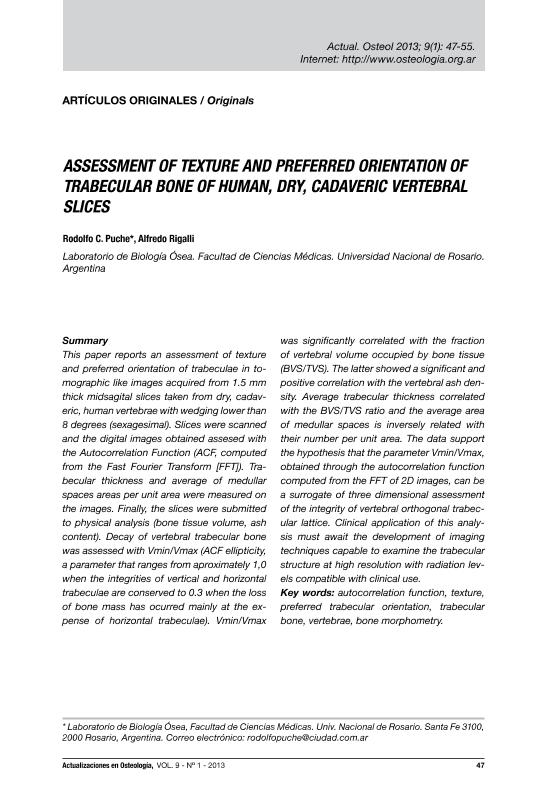Mostrar el registro sencillo del ítem
dc.contributor.author
Puche, Rodolfo Carlos Tomas

dc.contributor.author
Rigalli, Alfredo

dc.date.available
2017-07-28T19:57:45Z
dc.date.issued
2013-05
dc.identifier.citation
Puche, Rodolfo Carlos Tomas; Rigalli, Alfredo; Assessment of texture and preferred orientation of trabecular bone of human, dry, cadaveric vertebral slices; Asociación Argentina de Osteología y Metabolismo Mineral; Actualizaciones en Osteología; 9; 1; 5-2013; 47-55
dc.identifier.issn
1669-8975
dc.identifier.uri
http://hdl.handle.net/11336/21574
dc.description.abstract
This paper reports an assessment of texture and preferred orientation of trabeculae in tomographic like images acquired from 1.5 mm thick midsagital slices taken from dry, cadaveric, human vertebrae with wedging lower than 8 degrees (sexagesimal). Slices were scanned and the digital images obtained assesed with the Autocorrelation Function (ACF, computed from the Fast Fourier Transform [FFT]). Trabecular thickness and average of medullar spaces areas per unit area were measured on the images. Finally, the slices were submitted to physical analysis (bone tissue volume, ash content). Decay of vertebral trabecular bone was assessed with Vmin/Vmax (ACF ellipticity, a parameter that ranges from aproximately 1,0 when the integrities of vertical and horizontal trabeculae are conserved to 0.3 when the loss of bone mass has ocurred mainly at the expense of horizontal trabeculae). Vmin/Vmax was significantly correlated with the fraction of vertebral volume occupied by bone tissue (BVS/TVS). The latter showed a significant and positive correlation with the vertebral ash density. Average trabecular thickness correlated with the BVS/TVS ratio and the average area of medullar spaces is inversely related with their number per unit area. The data support the hypothesis that the parameter Vmin/Vmax, obtained through the autocorrelation function computed from the FFT of 2D images, can be a surrogate of three dimensional assessment of the integrity of vertebral orthogonal trabecular lattice. Clinical application of this analysis must await the development of imaging techniques capable to examine the trabecular structure at high resolution with radiation levels compatible with clinical use.
dc.description.abstract
Se presenta una evaluación de la textura y orientación preferida de las trabéculas óseas de imágenes obtenidas de cortes medio sagitales, de 1,5 mm de espesor de vértebras humanas, cadavéricas, secas, con acuñamiento inferior a 8 grados sexagesimales. Los cortes fueron escaneados y sus imágenes digitales evaluadas con la Función de Autocorrelación (ACF, computarizada a partir de la Transformada de Fourier [FFT]). El grosor de las trabéculas y el número y áreas de los espacios medulares fueron medidos en cada imagen. En cada corte se midieron el volumen de tejido óseo y el contenido de cenizas. La textura del tejido trabecular fue evaluada mediante el parámetro Vmin/Vmax (ACF, “ellipticity”, cuyo valor varía entre 1,0, cuando la integridad de las trabéculas verticales y horizontales está conservada y 0,3 cuando ocurre la pérdida de masa ósea principalmente a expensas de las trabéculas horizontales). Este parámetro correlacionó significativamente con BVS/TVS, la fracción del volumen vertebral ocupada por tejido óseo. La variable BVS/TVS se correlacionó significativa y positivamente con la densidad mineral del tejido vertebral. El grosor trabecular promedio se encontró correlacionado con BVS/TVS. El área promedio de los espacios medulares mostró una correlación exponencial negativa con su número por unidad de área. Este trabajo sugiere que el parámetro Vmin/Vmax puede subrogar la evaluación tridimensional de la integridad de la trama ortogonal de las trabéculas vertebrales. La aplicación clínica de este análisis deberá aguardar el desarrollo de tecnologías capaces de examinar la estructura trabecular con alta resolución a niveles de radiación compatibles con su uso clínico.
dc.format
application/pdf
dc.language.iso
eng
dc.publisher
Asociación Argentina de Osteología y Metabolismo Mineral
dc.rights
info:eu-repo/semantics/openAccess
dc.rights.uri
https://creativecommons.org/licenses/by-nc-sa/2.5/ar/
dc.subject
Bone
dc.subject
Trabecular Bone
dc.subject
Fft
dc.subject.classification
Otras Ciencias de la Salud

dc.subject.classification
Ciencias de la Salud

dc.subject.classification
CIENCIAS MÉDICAS Y DE LA SALUD

dc.title
Assessment of texture and preferred orientation of trabecular bone of human, dry, cadaveric vertebral slices
dc.title
Evaluación de la textura y orientación preferida del tejido trabecular de cortes de vértebras humanas, secas, cadavéricas
dc.type
info:eu-repo/semantics/article
dc.type
info:ar-repo/semantics/artículo
dc.type
info:eu-repo/semantics/publishedVersion
dc.date.updated
2017-07-28T18:01:02Z
dc.identifier.eissn
1669-8983
dc.journal.volume
9
dc.journal.number
1
dc.journal.pagination
47-55
dc.journal.pais
Argentina

dc.journal.ciudad
Rosario
dc.description.fil
Fil: Puche, Rodolfo Carlos Tomas. Universidad Nacional de Rosario. Facultad de Ciencias Médicas. Laboratorio de Biología Ósea; Argentina. Consejo Nacional de Investigaciones Científicas y Técnicas; Argentina
dc.description.fil
Fil: Rigalli, Alfredo. Universidad Nacional de Rosario. Facultad de Ciencias Médicas. Laboratorio de Biología Ósea; Argentina. Consejo Nacional de Investigaciones Científicas y Técnicas; Argentina
dc.journal.title
Actualizaciones en Osteología
dc.relation.alternativeid
info:eu-repo/semantics/altIdentifier/url/http://www.osteologia.org.ar/?s=ver_articulo&id=216&t=#detalle
Archivos asociados
